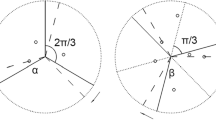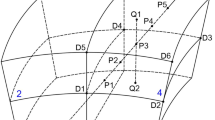Abstract
A new three-dimensional computerized ionospheric tomography model (VRS-ML-CIT) was developed in this study combining virtual reference station (VRS) and machine learning (ML) technology. Compared to the traditional VRS technology, the fitting and interpolation method generates virtual observations at each epoch. The ML technology was employed in this study to model both temporal and spatial variations of virtual observation in VRSs. Simultaneously, these ML-based VRSs are built associatively with unilluminated voxels (voxels without real observations) rather than relying solely on real reference stations, which can effectively reduce the proportion of unilluminated voxels, ensure the inversion efficiency, and improve the accuracy of virtual observations. We validate VRS-ML-CIT using observations of 153 GPS and two ionosonde stations in Europe. The results show that the test accuracy of the virtual observation is about 0.8 TECU, which offers an improvement of 40% over the previous non-machine learning VRS method. With the addition of virtual observations, the proportion of unilluminated voxels in VRS-ML-CIT declined from 30 to 12% on average. In comparison with the CIT result derived with only real observations (OBS-CIT), the error of the estimated slant total electron content in the proposed method reaches the same level for the illuminated voxels, even exceeding that of OBS-CIT in some periods. Moreover, the latitude–altitude maps and profiles of the IED from unilluminated voxels demonstrate the excellent performance of the proposed method.













Similar content being viewed by others
Data availability
The GPS observation data are available at ftp://ftp.epncb.oma.be/pub/obs. The ionosonde data are available at ftp://ftp.ngdc.noaa.gov/ionosonde/data. The Geomagnetic index data are available at https://wdc.kugi.kyoto-u.ac.jp/wdc/Sec3.html. The IRI2016 model data are available at https://ccmc.gsfc.nasa.gov/modelweb/models/iri2016_vitmo.php.
References
Angling MJ (2008) First assimilations of COSMIC radio occultation data into the electron density assimilative model (EDAM). Ann Geophys Ger 26:353–359
Austen JR, Franke SJ, Liu CH (1988) Ionospheric imaging using computerized tomography. Radio Sci 23(3):299–307
Bhuyan K, Singh S, Bhuyan P (2002) Tomographic reconstruction of the ionosphere using generalized singular value decomposition. Curr Sci India 83(9):1117–1120
Bilitza D, Altadill D, Truhlik V, Shubin V, Galkin I, Reinisch B, Huang X (2017) International reference ionosphere 2016: from ionospheric climate to real-time weather predictions. Space Weather 15:418–429
Bust GS, Garner TW, Gaussiran TL (2004) Ionospheric data assimilation three-dimensional (IDA3D): a global, multisensor, electron density specification algorithm. J Geophys Res Space Phys 109:A11312
Cai M, Li J, Liu L, Huang L, Zhou L, Huang L, He H (2022) Weighted mean temperature hybrid models in China based on artificial neural network methods. Remote Sens 14:3762
Chen T, Guestrin C (2016) XGBoost: a scalable tree boosting system. In: Proceedings of the 22nd ACM SIGKDD international conference on knowledge discovery and data mining, ACM
Chen B, Wu L, Dai W, Luo X, Xu Y (2019) A new parameterized approach for ionospheric tomography. GPS Solut 23(4):1
Feng J, Zhang T, Li W, Zhao Z, Han B, Wang K (2023) A new global TEC empirical model based on fusing multi-source data. GPS Solut 27(1):20
Ghaffari Razin MR, Voosoghi B (2016) Regional application of multi-layer artificial neural networks in 3-D ionosphere tomography. Adv Space Res 58(3):339–348
Ghaffari Razin MR, Voosoghi B (2017) Ionosphere tomography using wavelet neural network and particle swarm optimization training algorithm in Iranian case study. GPS Solut 21(3):1301–1314
Hirooka S, Hattori K, Nishihashi M, Kon S, Takeda T (2012) Development of ionospheric tomography using neural network and its application to the 2007 southern Sumatra earthquake. Electr Eng Jpn 181(4):9–18
Hirooka S, Hattori K, Takeda T (2011) Numerical validations of neural-network-based ionospheric tomography for disturbed ionospheric conditions and sparse data. Radio Sci 46(5):RS0F05
Hobiger T, Kondo T, Koyama Y (2008) Constrained simultaneous algebraic reconstruction technique (C-SART)—A new and simple algorithm applied to ionospheric tomography. Earth Planets Space 60(7):727–735
Jin R, Jin S, Feng G (2012) M_DCB: Matlab code for estimating GNSS satellite and receiver differential code biases. GPS Solut 16(4):541–548
Kunitake M, Ohtaka K, Maruyama T, Tokumaru M, Morioka A, Watanabe S (1995) Tomographic imaging of the ionosphere over Japan by the modified truncated SVD method. Ann Geophys 13(12):1303–1310
Lee J, Kamalabadi F, Makela J (2007) Localized three-dimensional ionospheric tomography with GPS ground receiver measurements. Radio Sci 42(4):RS4018
Li W, Chen P, Bei J, Wen H, Wang H (2012) Calibration of regional ionospheric delay with uncombined precise point positioning and accuracy assessment. J Earth Syst Sci 121(4):989–999
Li W, Yin Y, Quan X, Zhang H (2019) Gene expression value prediction based on XGBoost algorithm. Front Genet 10:1077
Lu W, Ma G, Wan Q, Li J, Wang X, Fu W, Maruyama T (2021) Virtual reference station-based computerized ionospheric tomography. GPS Solut 25:8
Ma X, Maruyama T, Ma G, Takeda T (2005) Three-dimensional ionospheric tomography using observation data of GPS ground receivers and ionosonde by neural network. J Geophys Res 110(A5):A05308
Nava B, Coisson P, Radicella S (2008) A new version of the NeQuick ionosphere electron density model. J Atmos Solar Terr Phys 70(15):1856–1862
Nygrén T, Markkanen M, Lehtinen M, Tereshchenko E, Khudukon B (1997) Stochastic inversion in ionospheric radio tomography. Radio Sci 32(6):2359–2372
Prol F, Hernández-Pajares M, Camargo P, Muella M (2018) Spatial and temporal features of the topside ionospheric electron density by a new model based on GPS radio occultation data. J Geophys Res Space Phys 123(3):2104–2115
Prol F, Camargo P, Hernandez-Pajares M, Muella M (2019) A new method for ionospheric tomography and its assessment by ionosonde electron density, GPS TEC, and single-frequency PPP. IEEE Trans Geosci Remote Sens 57(5):2571–2582
Pryse S, Kersley L, Rice D, Russell C, Walker I (1993) Tomographic imaging of the ionospheric mid-latitude trough. Ann Geophys 11(2–3):144–149
Raymund T, Austen J, Franke S, Liu C, Klobuchar J, Stalker J (1990) Application of computerized tomography to the investigation of ionospheric structures. Radio Sci 25(5):771–789
Saito S, Sunda S, Lee J, Pullen S, Supriadi S, Yoshihara T, Terkildsen M, Lecat F (2017) Ionospheric delay gradient model for GBAS in the Asia-Pacific region. GPS Solut 21:1937–1947
Sui Y, Fu H, Wang D, Xu F, Jin Y (2021) Sparse reconstruction of 3d regional ionospheric tomography using data from a network of GNSS reference stations. IEEE Trans Geosci Remote Sens 60:4102615
Wang S, Huang S, Xiang J, Fang H, Feng J, Wang Y (2016) Three-dimensional ionospheric tomography reconstruction using the model function approach in Tikhonov regularization. J Geophys Res Space Phys 121(12):104–115
Wen D, Liu S, Tang P (2010) Tomographic reconstruction of ionospheric electron density based on constrained algebraic reconstruction technique. GPS Solut 14(4):375–380
Yao Y, Chen P, Zhang S, Chen J (2013) A new ionospheric tomography model combining pixel-based and function-based models. Adv Space Res 52(4):614–621
Yao Y, Kong J, Tang J (2015) A new ionosphere tomography algorithm with two-grid virtual observations constraints and three-dimensional velocity profile. IEEE Trans Geosci Remote Sens 53(5):2373–2383
Yao Y, Zhai C, Kong J, Zhao Q, Zhao C (2018) A modified three-dimensional ionospheric tomography algorithm with side rays. GPS Solut 22(4):1–18
Zhai C, Lu G, Yao Y, Wang W, Zhang S, Liu J, Peng W, Kong J, Chen J (2020) 3-D tomographic reconstruction of SED plume during 17 March 2013 storm. J Geophys Res Space Phys 125(11):e2020JA028257
Zhao Q, Liu Y, Yao W, Yao Y (2022) Hourly rainfall forecast model using supervised learning algorithm. IEEE Trans Geosci Remote Sens 60:4105009
Zheng D, Yao Y, Nie W, Chu N, Lin D, AO M (2021a) A new three-dimensional computerized ionospheric tomography model based on a neural network. GPS Solut 25:10
Zheng D, Yao Y, Nie W, Chu N, Lin D, AO M (2021b) Ordered subsets-constrained ART algorithm for ionospheric tomography by combining VTEC data. IEEE Trans Geosci Remote Sens 59(8):7051–7061
Zheng D, Yao Y, Nie W, Lin D, Liang J, Chen C (2022) Iterative initial value refinement of ionospheric tomography algorithm based on machine learning ensemble algorithm. Chinese J Geophys-Ch 65(8):2796–2812
Zheng D, Yao Y, Nie W, Yang W, Hu W, Ao M, Zheng H (2018) An improved iterative algorithm for ionospheric tomography reconstruction by using the automatic search technology of relaxation factor. Radio Sci 53:1051
Zhou C, Fremouw E, Sahr J (1999) Optimal truncation criterion for application of singular value decomposition to ionospheric tomography. Radio Sci 34(1):155–166
Zou X, Ge M, Tang W, Shi C, Liu J (2013) URTK: undifferenced network RTK positioning. GPS Solut 17(3):283–293
Acknowledgements
The authors thank the anonymous reviewers for their valuable comments on the manuscript. We are grateful to the EUREF Permanent GNSS Network which provides the GPS observation data and also thank Lowell GIRO Data Center (LGDC) for providing the ionosonde data. This research was supported by the National Nature Science Foundation of China (No. 42004025, 42004012, 42104025, 42204037), The China Postdoctoral Science Foundation (No. 2021M702509); the Hunan Provincial Natural Science Foundation of China (No. 2022JJ30254); Natural Resources Science and Technology Project of Hunan Province (No. 2022-07, 2022-29).
Author information
Authors and Affiliations
Contributions
DZ wrote the main manuscript text. PY, CH and ZX calculated the STEC based on GNSS data and Nequick2 model. YY and CH participated in discussing the details of the proposed tomography method. WN provided the software of GNSS data processing. ML and DL participated in discussing the error handling method of the proposed method. All authors reviewed the manuscript.
Corresponding author
Ethics declarations
Competing interests
The authors declare no competing interests.
Additional information
Publisher's Note
Springer Nature remains neutral with regard to jurisdictional claims in published maps and institutional affiliations.
Rights and permissions
Springer Nature or its licensor (e.g. a society or other partner) holds exclusive rights to this article under a publishing agreement with the author(s) or other rightsholder(s); author self-archiving of the accepted manuscript version of this article is solely governed by the terms of such publishing agreement and applicable law.
About this article
Cite this article
Zheng, D., Yuan, P., He, C. et al. Virtual reference station technology for voxels without signal ray in ionospheric tomography based on machine learning. GPS Solut 27, 166 (2023). https://doi.org/10.1007/s10291-023-01512-7
Received:
Accepted:
Published:
DOI: https://doi.org/10.1007/s10291-023-01512-7




